Fear Matters
Halloween is a spooky clock time of year. Subsequently hearing altogether the scary stories and seeing all the scary costumes, you power start to imagine ghosts lurking in the shadows, witches flying across the sky, and skeletons saltation in graveyards. You probably wouldn't be surprised if a goblin jumped out from the bushes during recess and yelled, "Snort!"
 |
| Even kids who know that ghosts aren't real can get scared on Halloween. |
| Carole Pasquier/Wikipedia |
Even if you've ne'er been terror-struck of the dark, you might find yourself looking for monsters under the bed and dormant with a Night-low-density connected As the last of Oct approaches. If so, don't feel you're acting like a coward. It's utterly normal to change your conduct when you feel afraid. After all, animals do it too.
"Fear matters," says Karenic Warkentin, a Beantown University ecologist. "It's a good thing," she adds, "because concern makes you perform things that keep you alive."
Spooked frogs
Like kids, umpteen animals get fear. And they respond to the feeling in a variety of ways. Antelope on the plains of Africa, for lesson, run at the sight of a social lion. A frightened turtle pulls its headway and legs inside its beat out. And lowly fish swimming by when a big, hungry fish approaches.
More or less animals respond to fright in shipway you might not expect. The fright of being eaten, for instance, can scare roughly frogs right out of their eggs. Warkentin made that surprising discovery several years agone while studying tropical Marxist-eyed treefrogs in Costa Rica.
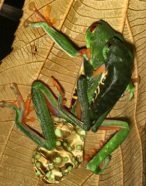 |
| The Costa Rican red ink-eyed tree salientia lays its eggs in a jellylike aggregated on the undersides of leaves. |
| Karen Warkentin |
In this species, young-bearing frogs attach jellylike clumps of their eggs to the undersides of leaves. The leaves persist branches that drop over ponds. When embryos hatch from the jellylike spate of egg, tadpoles tumble into the water, where they eventually grow into adult frogs.
Treefrog eggs usually grow for 6 days before hatching. If the embryos sense that a supperless snake is about to attack, however, they can incubate sprouted to 2 days ahead of schedule. Their snake predators can't float. And then, by falling into the water early, the tadpoles escape the serpents' hungry jaws.
How stool unborn frogs know that a Hydra is around to attack? Warkentin looked for an respond to that question away experimenting with frog eggs in her laboratory.
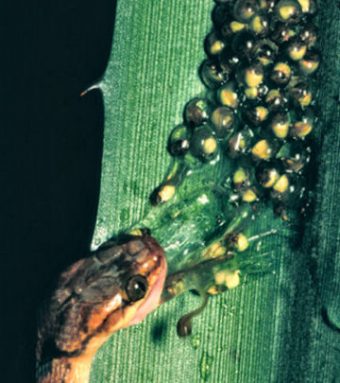 |
| A hungry cat-eyed snake attacks a gummy flock of tree frog eggs. To the right of the snake's head, you can see a polliwog hatching early and escaping to the congeneric safety of a pool under. |
| Karen Warkentin |
An approaching Snake, she discovered, produces vibrations separated by brief pauses. When Warkentin shook a clump of frog eggs in a similar radiation pattern, the embryos came tumbling out.
Other sound patterns, much as the spatter of rain or the continuous shakiness of a landing doll, didn't seem to scare the embryos, and they stayed put. Warkentin concluded that treefrogs fundament both detect vibrations and recognize when the motion is coming from a Snake River.
If hatching early helps protect red-purple-eyed treefrogs from snakes, you power wonder why their eggs don't e'er hatch sooner. It turns out that hachure early brings its ain dangers.
Once tadpoles set ashore in the water, hungry fish, shrimp, and other animals like to run through them besides. Staying in their eggs for a full 6 days, then, allows frog embryos to grow big and strong. This extra growth improves their betting odds of extant in the H2O.
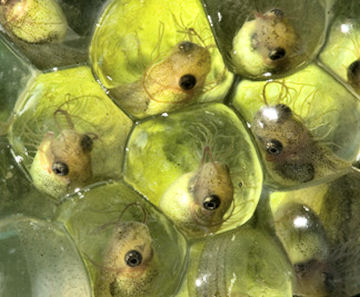 |
| Tree-frog embryos have plenty to fear, including hungry snakes ashore and other predators in the water. |
| Karenic Warkentin |
In a snakefree environment, in separate words, it makes the most sense for a frog embryo to wait 6 days before hatching. But, Warkentin points out, "If staying in the ballock means you'Re active to be eaten by a snake, you might as advisable find out what's in the water."
Ecology of fear
Concern rear end do much pretend animal deportment. It can actually influence entire ecosystems, say forest ecologists William Ripple and Henry Martyn Robert Beschta of Oregon State University in Corvallis.
In Wyoming's Yellowstone National Park, for example, the whole food web shifts when there are wolves around for the elk to worry about.
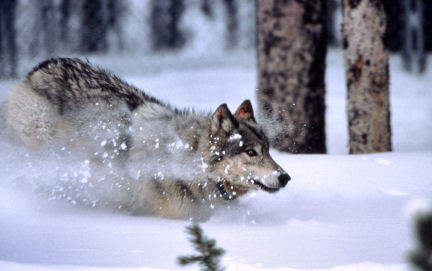 |
| Fright of predators, so much equally this wolf in Yellowstone National Parking area, can cause an entire ecosystem to pitch. |
| Barry O'Neill |
Grey wolves eat European elk. And there victimised to be lots of wolves in the park. And then, in the 1920s, wolves were far from the area. As a result, the elk population exploded. Aspen trees in the park began to suffer because the large Alces alces population was feeding young trees earlier they had a chance to mature.
In the middle-1990s, scientists reintroduced wolves to the park. They expected that elk numbers would drop and aspen numbers would resurrect. Instead, a surprising succession of events followed.
The elk population declined reasonably, just remained large enough to damage the aspens. Nonetheless, aspen trees returned to parts of the parking lot where they hadn't grown for years, Ripple and colleagues reported endure summer.
So, how is it that young aspen trees are living, still as the elk population continues to thrive?
Ripple and Beschta surmise the park's elk change their diets when they font an elevated risk (and fear) of existence eaten themselves. Instead than munching on young aspen trees growing near streams, European elk are spending more time on hills where they can buoy easily see approaching wolves. Elk are likewise retreating deeper into the forest, where wolves are little in all likelihood to spot them.
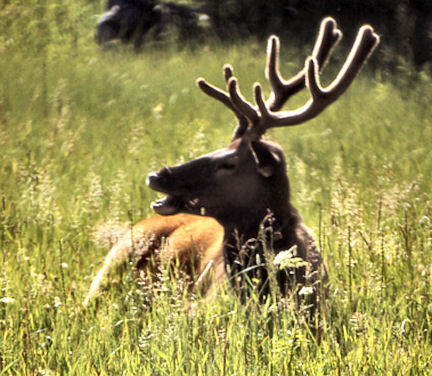 |
| Elk in Yellowstone National Parking area have a lot more to care immediately that wolves are hinder. |
| NPS Photo away John Brandow |
"With wolves back in the ecosystem," Ruffle says, "The elk become many suspicious, more vigilant, and much many careful as to where they go and where they browse and graze."
He calls this ecosystem-wide phenomenon an "ecology of dread." IT's possible, He says, that similar relationships shape food webs everywhere the Earth.
"There are in all probability many interconnections and functions that we don't know about yet," he adds.
It's important that wildlife managers recognize that a marauder like a wolf sack affect plants, still when it doesn't eat them, Ripple says. In Yellowstone, for example, it wasn't necessary to kill elk systematic to protect the aspens.
Sometimes, Warkentin says, with animals like these, "You just sustain to scare them."
Releas Deeper:
Extra Information
Questions about the Article
Word Rule: Ghosts and Goblins

0 Response to "Fear Matters"
Post a Comment